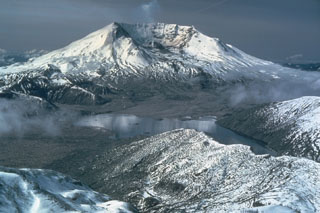Report on St. Helens (United States) — June 1981
Scientific Event Alert Network Bulletin, vol. 6, no. 6 (June 1981)
Managing Editor: Lindsay McClelland.
St. Helens (United States) Lava extrusion adds 5th lobe to crater dome
Please cite this report as:
Global Volcanism Program, 1981. Report on St. Helens (United States) (McClelland, L., ed.). Scientific Event Alert Network Bulletin, 6:6. Smithsonian Institution. https://doi.org/10.5479/si.GVP.SEAN198106-321050
St. Helens
United States
46.2°N, 122.18°W; summit elev. 2549 m
All times are local (unless otherwise noted)
The increased ground deformation and SO2 emission described last month were followed by an episode of lava extrusion atop the pre-existing composite dome that probably began late 18 June. The new lobe was roughly comparable in volume to lobes emplaced during previous extrusion episodes in October 1980, December 1980-January 1981, February 1981, and April 1981. A final volume figure awaits analysis of aerial photographs.
Seismicity began to increase during the evening of 17 June, and by afternoon seismographs were recording several events per hour. The seismic events were impulsive and of higher frequency than those that had typically accompanied previous eruptive episodes, but were centered directly beneath the crater within 1 km of the surface. The increased seismicity prompted an advisory alert notice, issued by the USGS and University of Washington at 1130 on 18 June, stating that a dome-building eruption was likely within the next day or two.
Between 1600 and 1700 on 18 June, the seismicity changed character to smaller, indistinct (non-impulsive) events, and the direction of tilt recorded by the single bubble tiltmeter (about 30 m from the NE margin of the dome) reversed. These changes were interpreted by the USGS as probably marking the beginning of lava extrusion, but cloudy weather prevented direct observation. As many as twelve of the indistinct seismic events, sometimes merging into bursts of noise, occurred each hour until about midnight, when the character of seismicity changed again to more typical low-frequency events with emergent arrivals. These events, some larger than those of the previous few hours, decreased gradually to number only a few per day by 22 June.
Poor weather prevented access to the crater until the afternoon of 19 June, when geologists observed new lava that had emerged from near the center of the pre-existing dome. The new lava covered an area roughly 300 m in both N-S and E-W dimensions, overriding portions of the lobes extruded in February and April and much of the talus at their margins. The June extrusion increased the height of the composite dome by around 50 m, but the top of the new lobe subsided 5-10 m between the afternoons of 19 and 20 June.
Between 29 May and the probable beginning of lava extrusion on 18 June, the bubble tiltmeter had recorded roughly 2000 µrad of tilt, in a direction consistent with other deformation data showing outward movement radial to the dome. Tilt rates increased from about 100 µrad/day during the first ten days of measurements to 140 µrad/day on 16 June, and to roughly 140 µrad/hr during the final 3 hours before the tilt reversal that probably marked the beginning of lava extrusion. Between the time of the tilt reversal and the rockfall that ended telemetry early 23 June, roughly half of the relative uplift recorded 29 May-18 June had been lost. In contrast to the pre-extrusion period, the post-extrusion record showed numerous features including instantaneous offsets probably associated with rockfalls and short-term tilt fluctuations. Present plans call for the installation of a network of telemetered bubble tiltmeters in the crater.
Geological Summary. Prior to 1980, Mount St. Helens was a conical volcano sometimes known as the Fujisan of America. During the 1980 eruption the upper 400 m of the summit was removed by slope failure, leaving a 2 x 3.5 km breached crater now partially filled by a lava dome. There have been nine major eruptive periods beginning about 40-50,000 years ago, and it has been the most active volcano in the Cascade Range during the Holocene. Prior to 2,200 years ago, tephra, lava domes, and pyroclastic flows were erupted, forming the older edifice, but few lava flows extended beyond the base of the volcano. The modern edifice consists of basaltic as well as andesitic and dacitic products from summit and flank vents. Eruptions in the 19th century originated from the Goat Rocks area on the N flank, and were witnessed by early settlers.
Information Contacts: T. Casadevall, D. Dzurisin, C. Newhall, D. Swanson, USGS, Vancouver, WA; C. Boyko, S. Malone, E. Endo, C. Weaver, University of Washington; R. Tilling, USGS, Reston, VA.

